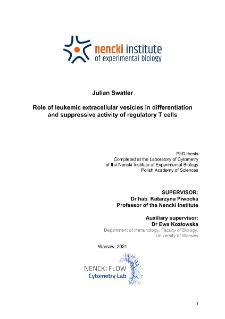
Object
Title: Role of leukemic extracellular vesicles in differentiation and suppressive activity of regulatory T cells : PhD thesis
Institutional creator:
Instytut Biologii Doświadczalnej im. Marcelego Nenckiego PAN ; Uniwersytet Warszawski
Contributor:
Piwocka, Katarzyna (1970– ) : Supervisor ; Kozłowska, Ewa : Assistant supervisor
Publisher:
Nencki Institute of Experimental Biology PAS
Place of publishing:
Description:
175, [1] pages : illustrations ; 30 cm ; Afiliation of auxiliary supervisor: University of Warsaw ; Bibliography ; Summary in Polish
Degree grantor:
Instytut Biologii Doświadczalnej im. Marcelego Nenckiego PAN
Type of object:
Abstract:
Chronic and acute myeloid leukemia (CML/AML) constitute cancers that arise in the bone marrow, due to malignant transformation (by oncogenic mutations such as BCR-ABL1, FLT3-ITD and others) of myeloid progenitor cells. As myeloid leukemias develop, they expand outside the bone marrow and engraft other tissues, such as the spleen or blood. Development and expansion of myeloid leukemias has been recently shown to be significantly facilitated by immunosuppression - a state when anti-tumor immunity is attenuated and dysfunctional. Immunosuppression is largely established by suppressive cell subsets of the immune system, such as regulatory T cells (Tregs) - a type of T cells that express transcription factor Foxp3 and perform tolerogenic/suppressive function. Tregs have been shown to be upregulated in blood and bone marrow of patients with myeloid leukemias. However, as this has only recently been described, mechanisms that drive expansion and suppressive activity of Tregs in leukemias remain largely unexplored. This thesis has aimed at dissecting modulation of Tregs by leukemic extracellular vesicles (EVs) - small, lipid bilayer-enclosed structures released outside cells as mediators of intercellular communication. As EVs have been demonstrated to modulate non-immune components of the leukemic bone marrow niche and have been shown to interact with Tregs in solid tumors, they might also constitute drivers of Foxp3+ regulatory T cells in myeloid leukemias. Using ex vivo cultures of murine and human Tregs with EVs released by CML and AML cell lines, leukemic EVs were shown to upregulate suppressive phenotype and activity of Tregs, as well as level of Foxp3. Leukemic EVs also induced Foxp3 expression in non-regulatory, conventional T cells. Leukemic EVs have upregulated phosphorylation of STAT5 and downregulated mTOR-S6 signaling in T cells to promote Treg induction, activity and stability. RNA-sequencing has revealed significant remodeling of Treg transcriptome by leukemic EVs, upregulated expression of tumor Treg genes and several transcription factors engaged in this regulation. Furthermore, 23-color spectral flow cytometry and unsupervised clustering tools have revealed 2 subsets of human effector Tregs (eTreg) expanded by leukemic EVs - CD30+CCR8hiTNFR2hi eTreg1 and CD39+TIGIThi eTreg2. Mass spectrometric analysis of leukemic EVs' proteome revealed presence of TNF superfamily protein 4-1BBL, which was engaged in modulation of expression of effector molecules (CD30, TNFR2, LAG-3) on Tregs. Finally, in a developed immunocompetent mouse model of CML-like disease, influence of EVs on Tregs and leukemic progression was validated by development of leukemia by Rab27a deficient cells, with attenuated secretion of EVs. Rab27a deficient leukemia has exhibited reduced engraftment in animals, whereas Tregs were less abundant and exhibited a less activated, less suppressive phenotype than in wild type counterparts. Altogether, data presented in this thesis pin-point extracellular vesicles, released by chronic and acute myeloid leukemia cells, as significant modulators of regulatory T cells - their induction, suppressive phenotype, function and effector subsets. In vivo, in a mouse model of leukemia-like disease, Rab27a-mediated secretion of EVs was shown to modulate Tregs and leukemic engraftment. Therefore, EVs and EVs-Tregs interaction may be evaluated as potential therapeutic targets in myeloid neoplasms
Detailed Resource Type:
Resource Identifier:
Source:
Language:
Language of abstract:
Digitizing institution:
Nencki Institute of Experimental Biology of the Polish Academy of Sciences
Original in:
Library of the Nencki Institute of Experimental Biology PAS
Access:
Object collections:
- Digital Repository of Scientific Institutes > Partners' collections > Nencki Institute of Experimental Biology PAS
- Digital Repository of Scientific Institutes > Partners' collections > Nencki Institute of Experimental Biology PAS > Dissertations
- Digital Repository of Scientific Institutes > Partners' collections > Nencki Institute of Experimental Biology PAS > Dissertations > PhD Thesis
- Digital Repository of Scientific Institutes > Literature > Thesis
Last modified:
Dec 22, 2023
In our library since:
Jun 21, 2022
Number of object content downloads / hits:
46
All available object's versions:
https://rcin.org.pl/publication/272254
Show description in RDF format:
Show description in RDFa format:
Show description in OAI-PMH format:
Objects Similar
Stukan, Iga
Głuchowska, Agata
Mossakowski, Mirosław Jan (1929–2001) Kraśnicka, Zuzanna Iwanowski, Lech
Mossakowski, Mirosław Jan (1929–2001)
Zelman, Irmina B. (1927–2010)

 INSTYTUT ARCHEOLOGII I ETNOLOGII POLSKIEJ AKADEMII NAUK
INSTYTUT ARCHEOLOGII I ETNOLOGII POLSKIEJ AKADEMII NAUK
 INSTYTUT BADAŃ LITERACKICH POLSKIEJ AKADEMII NAUK
INSTYTUT BADAŃ LITERACKICH POLSKIEJ AKADEMII NAUK
 INSTYTUT BADAWCZY LEŚNICTWA
INSTYTUT BADAWCZY LEŚNICTWA
 INSTYTUT BIOLOGII DOŚWIADCZALNEJ IM. MARCELEGO NENCKIEGO POLSKIEJ AKADEMII NAUK
INSTYTUT BIOLOGII DOŚWIADCZALNEJ IM. MARCELEGO NENCKIEGO POLSKIEJ AKADEMII NAUK
 INSTYTUT BIOLOGII SSAKÓW POLSKIEJ AKADEMII NAUK
INSTYTUT BIOLOGII SSAKÓW POLSKIEJ AKADEMII NAUK
 INSTYTUT CHEMII FIZYCZNEJ PAN
INSTYTUT CHEMII FIZYCZNEJ PAN
 INSTYTUT CHEMII ORGANICZNEJ PAN
INSTYTUT CHEMII ORGANICZNEJ PAN
 INSTYTUT FILOZOFII I SOCJOLOGII PAN
INSTYTUT FILOZOFII I SOCJOLOGII PAN
 INSTYTUT GEOGRAFII I PRZESTRZENNEGO ZAGOSPODAROWANIA PAN
INSTYTUT GEOGRAFII I PRZESTRZENNEGO ZAGOSPODAROWANIA PAN
 INSTYTUT HISTORII im. TADEUSZA MANTEUFFLA POLSKIEJ AKADEMII NAUK
INSTYTUT HISTORII im. TADEUSZA MANTEUFFLA POLSKIEJ AKADEMII NAUK
 INSTYTUT JĘZYKA POLSKIEGO POLSKIEJ AKADEMII NAUK
INSTYTUT JĘZYKA POLSKIEGO POLSKIEJ AKADEMII NAUK
 INSTYTUT MATEMATYCZNY PAN
INSTYTUT MATEMATYCZNY PAN
 INSTYTUT MEDYCYNY DOŚWIADCZALNEJ I KLINICZNEJ IM.MIROSŁAWA MOSSAKOWSKIEGO POLSKIEJ AKADEMII NAUK
INSTYTUT MEDYCYNY DOŚWIADCZALNEJ I KLINICZNEJ IM.MIROSŁAWA MOSSAKOWSKIEGO POLSKIEJ AKADEMII NAUK
 INSTYTUT PODSTAWOWYCH PROBLEMÓW TECHNIKI PAN
INSTYTUT PODSTAWOWYCH PROBLEMÓW TECHNIKI PAN
 INSTYTUT SLAWISTYKI PAN
INSTYTUT SLAWISTYKI PAN
 SIEĆ BADAWCZA ŁUKASIEWICZ - INSTYTUT TECHNOLOGII MATERIAŁÓW ELEKTRONICZNYCH
SIEĆ BADAWCZA ŁUKASIEWICZ - INSTYTUT TECHNOLOGII MATERIAŁÓW ELEKTRONICZNYCH
 MUZEUM I INSTYTUT ZOOLOGII POLSKIEJ AKADEMII NAUK
MUZEUM I INSTYTUT ZOOLOGII POLSKIEJ AKADEMII NAUK
 INSTYTUT BADAŃ SYSTEMOWYCH PAN
INSTYTUT BADAŃ SYSTEMOWYCH PAN
 INSTYTUT BOTANIKI IM. WŁADYSŁAWA SZAFERA POLSKIEJ AKADEMII NAUK
INSTYTUT BOTANIKI IM. WŁADYSŁAWA SZAFERA POLSKIEJ AKADEMII NAUK


































